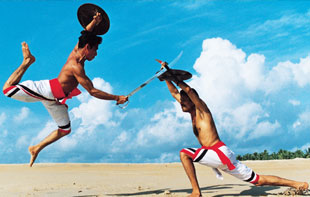Kerala.com Travel Division
WorldViewer Dot Com (India) Pvt. Ltd.
II Floor, G 66, Elders Forum Road
Panampilly Nagar, Cochin, Kerala, India
Pin - 682 036
Mobile: + 91 98460 43403
Mobile: + 91 93886 40364

 Kalarippayattu is an exclusive form of one of the most ancient traditional systems of physical, culture, self-defence and martial art form/technique whose origin can be traced to the northern and western parts of Kerala, in and around Kannur and Kozhikode.
Kalarippayattu is an exclusive form of one of the most ancient traditional systems of physical, culture, self-defence and martial art form/technique whose origin can be traced to the northern and western parts of Kerala, in and around Kannur and Kozhikode.
It was believed that the ‘Nayakanmasr’ were given the charge of Kalaris. These Nayakanmars gradually came to be called the ‘Nayars’, in some regions, special titles like ‘Kurup’, ‘Nambiar’, ‘Panikkar’ etc were given. The ‘Nayar’ who had charge of a particular Kalari or group of Kalaris for the training and upbringing of warriors was called the ‘Gurukkal’ (meaning teacher or instructor) of the Kalari or Kalaris. Kalaris were established in all the ancestral homes of those Nayars to impart training in the methods of defence and offence.
In Sanskrit language, the word ‘Khaloorika’ denotes a place where weapon training is practised. It is believed that it was from the Sanskrit term ‘Khaloorika’, that the word ‘Kalari’ came into use in Malayalam for similar institutions imparting training in martial arts. Such institutions were there throughout the country where similar training was imparted. In each region, they are known by different names according to the differences in the regional languages. All these terms are believed to have originated from the Sanskrit term ‘Khaloorika’ as in the case of the ‘Kalari’. The system of physical and weapon training imparted within the Kalari came to be called ‘Kalarippayattu.
Self defence
There are known to be two forms of Kalari, one Vatakkan ‘Northern’ and another one Tekkan ‘Southern’. In Vatakkan, three types viz Arappukkai, Pillattaanni and Vatteel tirippu were the most important and they had wide publicity. It is believed that Sage Agastya was the Guru of Tekkan form of Kalari. The Tekkan type was more important than Vadakkan. But the use of different kinds of weapons and the beauty of performance made the Vadakkan Kalari become famous. Kalaris were primarily of two types, the first being smaller known as ‘CheruKalari’ (cheru means small) or KuzhiKalari (kuzhi means the portions formed by the caving in of the earth) and the second one known as ‘AnkaKalari’ (Ankam means fight). It is called KuzhiKalari because the floor of the Kalari is built at a level lower than the surrounding land by removing soil to achieve the necessary depth. CheruKalari or KuzhiKalari was built for the purpose of impailing physical and weapon training. It was in this Kalari that systematic training in scientific exercises in Kalarippayattu was imparted. Remnants of such ancient ‘Kalaris’ are seen at some places in the Malabar region of Kerala especially Kozhikode and Kannur.
There are very many kalari schools available in Kozhikode, Kannur and other regions of Kerala today that impart training to youth in this unique art form.
For more information on the land of folklore, log on to kannoor.com
For Accommodation - Hotels / Resorts / Homestays in Kannur
WorldViewer Dot Com (India) Pvt. Ltd.
II Floor, G 66, Elders Forum Road
Panampilly Nagar, Cochin, Kerala, India
Pin - 682 036
Mobile: + 91 98460 43403
Mobile: + 91 93886 40364

Kerala Districts : Alappuzha | Ernakulam | Idukki | Kannur | Kollam | Kottayam | Kozhikode | Kasargod | Malappuram | Pathanamthitta |Palakkad | Thiruvananthapuram | Trichur | Wayanad
Other Destinations :Nelliyampathy | Kodanad | Fortkochi | Marari | Kulamavu| Cherai | Kanyakumari | Kumbalangi| Kuttikanam | Ramakkalmedu|Vaikom |